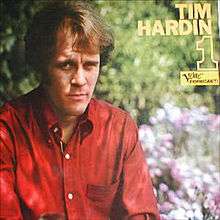Tim Hardin 1
| Tim Hardin 1 | ||||
|---|---|---|---|---|
 | ||||
| Studio album by Tim Hardin | ||||
| Released | July 1966 | |||
| Recorded | May & November 1964, December 1965 | |||
| Genre | Folk | |||
| Length | 27:21 | |||
| Label | Verve Forecast | |||
| Producer | Erik Jacobsen | |||
| Tim Hardin chronology | ||||
| ||||
Tim Hardin 1 is the debut album by folk artist Tim Hardin, released in 1966 on Verve Records.
History
Tim Hardin 1 contains one of his most well-known and frequently covered songs, "Reason to Believe" — most notably a hit by Rod Stewart in 1971. Some of the songs were demos that ended up on the final release. Hardin was reportedly displeased with the string arrangements added after principal recording was completed.[1]
The album cover was shot in the garden of "The Castle" where Bob Dylan was staying during that time. The cover and all the photos on the back were taken by Lisa Law. One of the outtakes of this album shoot was used for Hardin's last album as well as he died the day Law was to photograph him for his new album, Hang On to a Dream.
Tim Hardin 1 was re-released on CD in 1998 by Repertoire along with Tim Hardin 2.[2]
Reception
| Professional ratings | |
|---|---|
| Review scores | |
| Source | Rating |
| Allmusic | |
Allmusic stated in their review: "Tim Hardin 1 is one of the most powerful and compelling records of its era (...) The result is a seminal folk-rock album, every bit as exciting and urgent as it was in 1966, and as important a creative effort as Bob Dylan's Bringing It All Back Home and Highway 61 Revisited. And this wasn't even Hardin's best album, though it set the pattern for everything he did after."[3]
Track listing
All songs written by Tim Hardin.
- Side one
- "Don't Make Promises" – 2:26
- "Green Rocky Road" – 2:18
- "Smugglin' Man" – 1:57
- "How Long" – 2:54
- "While You're On Your Way" – 2:17
- "It'll Never Happen Again" – 2:37
- Side two
- "Reason to Believe" – 2:00
- "Never Too Far" – 2:16
- "Part of the Wind" – 2:19
- "Ain't Gonna Do Without" – 2:13
- "Misty Roses" – 2:00
- "How Can We Hang On to a Dream?" – 2:04
Personnel
- Tim Hardin – vocals, guitar, keyboards
- Gary Burton – vibraphone
- Bob Bushnell – bass
- Earl Palmer – drums
- Buddy Salzman – drums
- Jon Wilcox – drums
- John Sebastian – harmonica
- Phil Kraus – background vocals
- Walter Yost – bass
- Artie Butler – string arrangements
- Val Valentin - engineer
- Lisa Bachelis - photography
References
- ↑ Rough Guide to Rock bio.
- ↑ Allmusic entry for compilation of Tim Hardin 1 and 2.
- 1 2 Eder, Bruce. "Tim Hardin 1 > Review". Allmusic. Retrieved June 22, 2011.